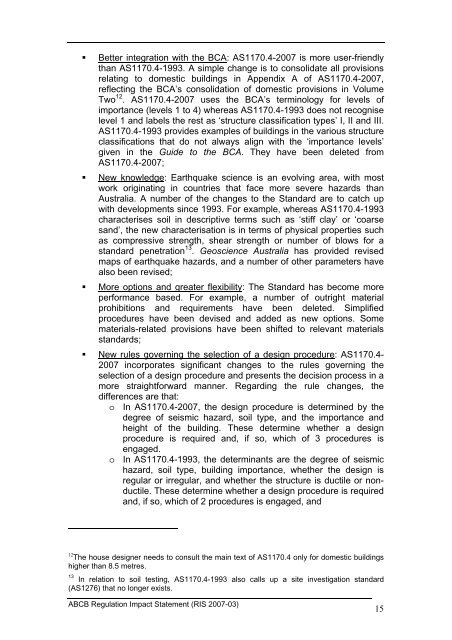PDF | 2 MB - Australian Building Codes Board
PDF | 2 MB - Australian Building Codes Board
PDF | 2 MB - Australian Building Codes Board
Create successful ePaper yourself
Turn your PDF publications into a flip-book with our unique Google optimized e-Paper software.
• Better integration with the BCA: AS1170.4-2007 is more user-friendly<br />
than AS1170.4-1993. A simple change is to consolidate all provisions<br />
relating to domestic buildings in Appendix A of AS1170.4-2007,<br />
reflecting the BCA’s consolidation of domestic provisions in Volume<br />
Two 12 . AS1170.4-2007 uses the BCA’s terminology for levels of<br />
importance (levels 1 to 4) whereas AS1170.4-1993 does not recognise<br />
level 1 and labels the rest as ‘structure classification types’ I, II and III.<br />
AS1170.4-1993 provides examples of buildings in the various structure<br />
classifications that do not always align with the ‘importance levels’<br />
given in the Guide to the BCA. They have been deleted from<br />
AS1170.4-2007;<br />
• New knowledge: Earthquake science is an evolving area, with most<br />
work originating in countries that face more severe hazards than<br />
Australia. A number of the changes to the Standard are to catch up<br />
with developments since 1993. For example, whereas AS1170.4-1993<br />
characterises soil in descriptive terms such as ‘stiff clay’ or ‘coarse<br />
sand’, the new characterisation is in terms of physical properties such<br />
as compressive strength, shear strength or number of blows for a<br />
standard penetration 13 . Geoscience Australia has provided revised<br />
maps of earthquake hazards, and a number of other parameters have<br />
also been revised;<br />
• More options and greater flexibility: The Standard has become more<br />
performance based. For example, a number of outright material<br />
prohibitions and requirements have been deleted. Simplified<br />
procedures have been devised and added as new options. Some<br />
materials-related provisions have been shifted to relevant materials<br />
standards;<br />
• New rules governing the selection of a design procedure: AS1170.4-<br />
2007 incorporates significant changes to the rules governing the<br />
selection of a design procedure and presents the decision process in a<br />
more straightforward manner. Regarding the rule changes, the<br />
differences are that:<br />
o In AS1170.4-2007, the design procedure is determined by the<br />
degree of seismic hazard, soil type, and the importance and<br />
height of the building. These determine whether a design<br />
procedure is required and, if so, which of 3 procedures is<br />
engaged.<br />
o In AS1170.4-1993, the determinants are the degree of seismic<br />
hazard, soil type, building importance, whether the design is<br />
regular or irregular, and whether the structure is ductile or nonductile.<br />
These determine whether a design procedure is required<br />
and, if so, which of 2 procedures is engaged, and<br />
12 The house designer needs to consult the main text of AS1170.4 only for domestic buildings<br />
higher than 8.5 metres.<br />
13<br />
In relation to soil testing, AS1170.4-1993 also calls up a site investigation standard<br />
(AS1276) that no longer exists.<br />
ABCB Regulation Impact Statement (RIS 2007-03)<br />
15
















